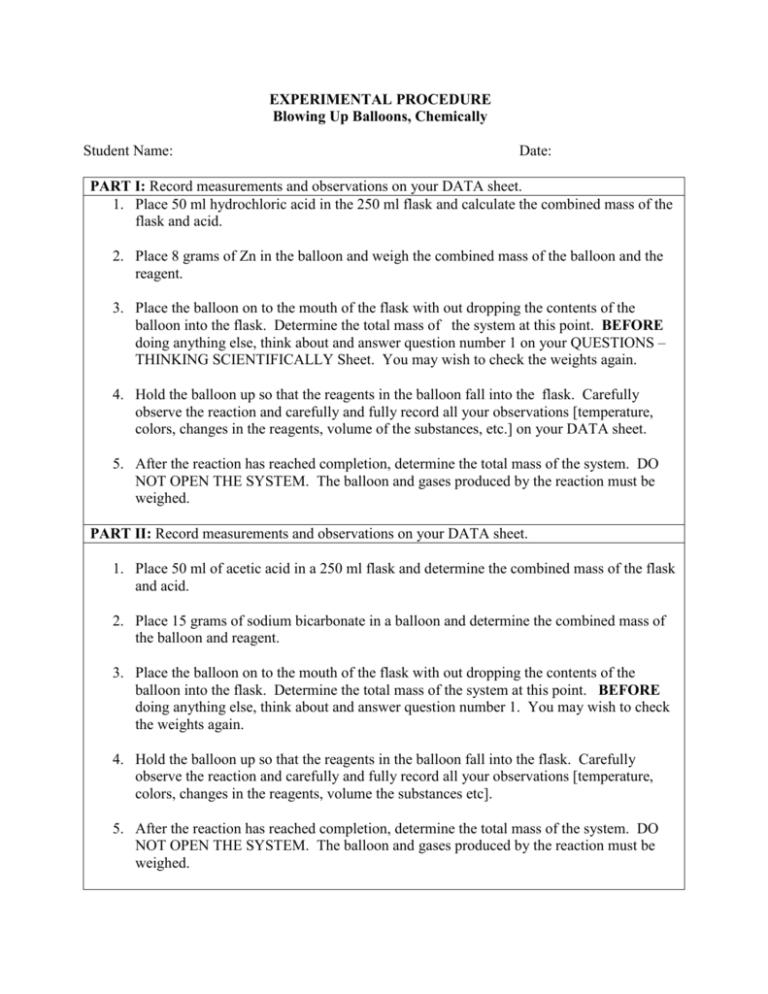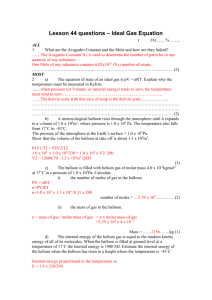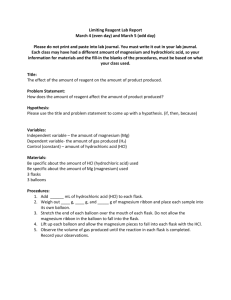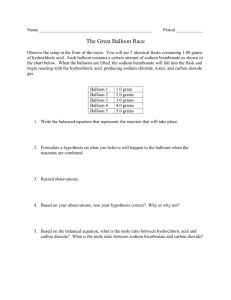Student Handouts
advertisement

EXPERIMENTAL PROCEDURE Blowing Up Balloons, Chemically Student Name: Date: PART I: Record measurements and observations on your DATA sheet. 1. Place 50 ml hydrochloric acid in the 250 ml flask and calculate the combined mass of the flask and acid. 2. Place 8 grams of Zn in the balloon and weigh the combined mass of the balloon and the reagent. 3. Place the balloon on to the mouth of the flask with out dropping the contents of the balloon into the flask. Determine the total mass of the system at this point. BEFORE doing anything else, think about and answer question number 1 on your QUESTIONS – THINKING SCIENTIFICALLY Sheet. You may wish to check the weights again. 4. Hold the balloon up so that the reagents in the balloon fall into the flask. Carefully observe the reaction and carefully and fully record all your observations [temperature, colors, changes in the reagents, volume of the substances, etc.] on your DATA sheet. 5. After the reaction has reached completion, determine the total mass of the system. DO NOT OPEN THE SYSTEM. The balloon and gases produced by the reaction must be weighed. PART II: Record measurements and observations on your DATA sheet. 1. Place 50 ml of acetic acid in a 250 ml flask and determine the combined mass of the flask and acid. 2. Place 15 grams of sodium bicarbonate in a balloon and determine the combined mass of the balloon and reagent. 3. Place the balloon on to the mouth of the flask with out dropping the contents of the balloon into the flask. Determine the total mass of the system at this point. BEFORE doing anything else, think about and answer question number 1. You may wish to check the weights again. 4. Hold the balloon up so that the reagents in the balloon fall into the flask. Carefully observe the reaction and carefully and fully record all your observations [temperature, colors, changes in the reagents, volume the substances etc]. 5. After the reaction has reached completion, determine the total mass of the system. DO NOT OPEN THE SYSTEM. The balloon and gases produced by the reaction must be weighed. DATA SHEET Blowing Up Balloons, Chemically Student Name: Date: PART 1 Mass of flask and HCl: Mass of balloon and zinc: Total: Mass of flask, acid, balloon & zinc before the reaction: Mass of apparatus and chemicals after the reaction: Changes observed in the system as it reacted (both physical & chemical). PART 2: Mass of flask and acid: Mass of balloon and NaHCO3: Total: Mass of flask, acid, balloon & chemicals before the reaction: Mass of apparatus and chemicals after the reaction: Changes observed in the system as it reacted (both physical & chemical). QUESTIONS – THINKING SCIENTIFICALLY Blowing Up Balloons, Chemically Student Name: Date: 1. Is the total mass of the chemical system equal to the sum of the mass of flask and acid plus the mass of the balloon and reagents? ________ Why or why not? 2. Is there a difference in the mass of the system after the chemical reaction? ________ Why or why not? 3. Is the zinc and hydrochloric acid reaction endothermic or exothermic? ________ How did you determine this? 4. Is the sodium bicarbonate and acetic acid reaction endothermic or exothermic? ________ How did you determine this? 5. What physical changes did you observe? 6. What chemical changes did you observe 8. How does the "law of the conservation of matter" apply in this experiment? 9. How does the “law of the conservation of matter” apple to your life? Give three examples. 1. 2. 3 .








